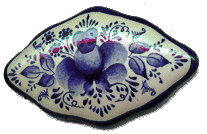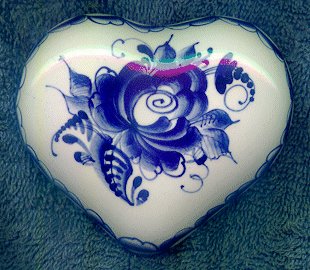



Gzhel majolica is the first page in the history of Russian ornamented folk ceramics. At that time nearly the whole population of the 30 villages in the Gzhel region was engaged in the production of majolica. The majolica of the eighteenth century was predominately decorated in shades of blue, green, yellow, and brown. It included scenes of villages, birds, and animals with flowers and trees. They made figures and decorative objects as well as tableware which commonly included pitchers, kvass jugs, kumgans, salt cellars, plates, bratinas, and ink pots. Pitchers in the shape of a double-headed eagle were popular. The kvass jugs were typically a doughnut shaped form with a hole in the middle, mounted on four lion's paws. They had scroll shaped handles and spouts, and often had three-dimensional figures and vines playing about the handle, neck and spout.
In the nineteenth century they switched over to the production of semi- faience. Semi-faience is white, and after firing was ornamented with blue and covered with a transparent glaze. The objects and their forms differed little from the earlier majolica, but the colors of blue and white changed their appearance. There were fewer landscapes and more floral designs, with empire- style vines and festoons being very popular.
Within fifty years, the Gzhel factories had mastered the manufacture of all the basic types of ornamented pottery.
During Soviet times, the Gzhel factory began producing porcelain which has regained the traditions of the original majolica and semi-faience.
Today the Gzhel factory produces mostly a kind of ceramic, in blue and white. The combination of the white background with the blue design, decorated mostly with a floral pattern, is a distinctive feature of Gzhel pottery. The craftsmen of today try to retain the features and basic patterns characteristic of the famous majolica produced in the eighteenth century. Each piece is hand painted so you can always be sure that your piece of Gzhel will never be exactly like anyone else's.
The local clay is of extremely high quality and, if properly treated, turns pure white. Gzhel occupies a special place in the history of Russian ceramics, not only as a center of the craft of folk pottery, but also as a supplier of clay to many factories in other places.









